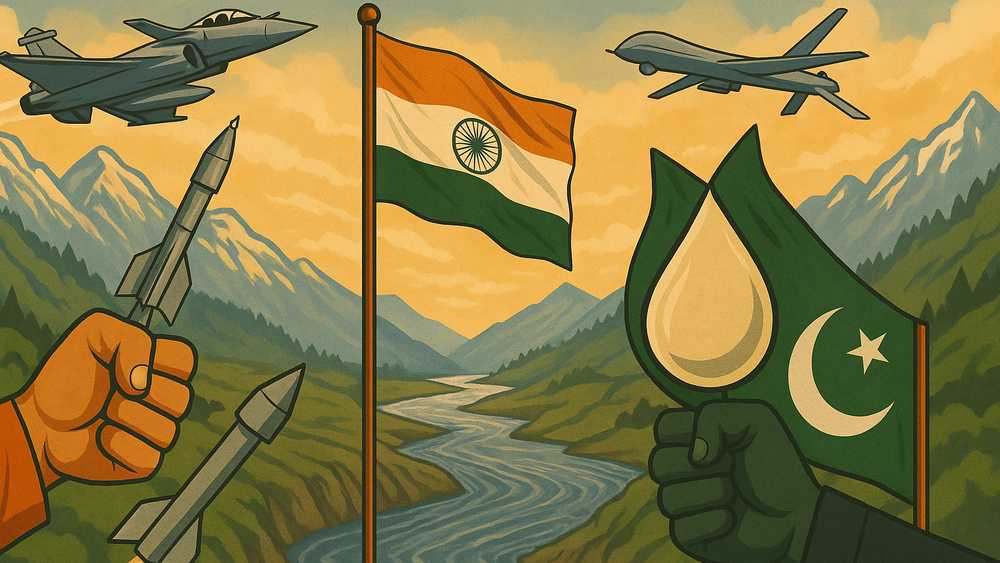RED ALERT: Could Nuclear Fallout from India Reach KATHMANDU? The Terrifying Truth!

Kathmandu – As tensions simmer yet again between our nuclear-armed neighbours, India and Pakistan, anxieties ripple across Nepal. While the prospect of a full-blown nuclear war remains unlikely, the catastrophic consequences – should the unthinkable happen – demand sober analysis, particularly given Nepal's profound vulnerability. Recent escalations following attacks in Kashmir serve as a stark reminder of the fragile peace in our region.
Analyses often point to concerns regarding the command and control of nuclear arsenals, particularly in contexts of political instability. Some international observers express fear that Pakistan, described often as a developing democracy facing internal challenges, might, under extreme duress, employ its nuclear capability irresponsibly. These fears persist despite strong international norms against nuclear use.
Deterrence, Diplomacy, and Dangerous Rhetoric
However, it's crucial to maintain perspective. The vast majority of citizens in both India and Pakistan yearn for peace, not war. The sheer destructive power of nuclear weapons acts as a potent deterrent for both sides. Furthermore, the international community stands firmly united against nuclear aggression. Any nation resorting to nuclear weapons would face complete global isolation and condemnation.
We often witness political bravado on the world stage that falls short of actual conflict. One recalls North Korea's leader boasting of a nuclear button, only for the then-US President Trump to retort he had a "bigger" one. Such exchanges, while alarming, often remain rhetorical.
Yet, the regional dynamic is complicated by persistent allegations, particularly from New Delhi, that Pakistan supports or turns a blind eye to extremist groups operating from its soil – groups accused of perpetrating attacks like the recent one in Pahalgam. Some analysts argue this fits a pattern where stability is undermined, potentially exploiting the caution inherent in democratic states like India. While these allegations fuel tensions, concrete proof often remains contested, and Pakistan denies state involvement.
Despite these undercurrents, robust international discouragement of nuclear conflict significantly lowers the probability of war. Diplomacy, however strained, continues.
The Psychological Toll and Media's Role
Even without active conflict, the psychological impact is palpable. The fear of war percolates through society, fueled by uncertainty. Media outlets play a critical role here. Sensationalist reporting can inflame public emotions. There's a real danger that journalists in both India and Pakistan could become increasingly polarized, amplifying nationalistic fervor and making peaceful resolution more difficult.
Hypothetical Nightmare: If Deterrence Fails
Should the worst-case scenario unfold, the consequences would dwarf any disaster previously witnessed.
- For India (and Pakistan): Targeted cities would face immediate annihilation from blast waves and firestorms, killing millions instantly. Vast areas would be contaminated by radioactive fallout, rendering land uninhabitable, poisoning food and water sources for decades. Healthcare systems would collapse, leading to disease, famine, and societal breakdown.
- For the World: Scientific models predict even a "limited" regional nuclear exchange could trigger a "nuclear winter." Soot from burning cities lofted into the stratosphere would block sunlight, causing global temperatures to plummet for years. This climate disruption would lead to worldwide crop failures, mass famine, and potential ozone layer depletion, increasing harmful UV radiation.
Nepal: Facing Existential Threats
For Nepal, situated directly adjacent to potential conflict zones in North India, the impacts would be existential, even without being directly targeted.
- Fallout Danger: Prevailing winds could easily carry lethal radioactive fallout across our borders, particularly into the Terai plains and potentially mountain valleys. This poses immediate health risks (radiation sickness) and long-term threats (cancer clusters). Our environment, food, and water could be poisoned.
- Economic Annihilation: Nepal's lifeline runs through India. Our nation heavily relies on imports for essentials: food grains, fuel, medicines, fertilizers, and consumer goods. We do not produce nearly enough food to sustain our population. A war, especially a nuclear one, would instantly sever these supply chains. Imports from India would cease, and access via Indian ports for goods from third countries would likely be cut off. Remittances from Nepalis in India would vanish. The result would be catastrophic shortages, hyperinflation, and economic collapse unlike anything ever experienced.
- Humanitarian Crisis: Besides fallout, Nepal could face an influx of desperate refugees fleeing devastated areas in India, overwhelming our already strained resources and infrastructure.
Echoes of Hiroshima, Magnified
The world saw the horror of nuclear weapons in Hiroshima and Nagasaki in 1945. Single bombs instantly vaporized city centers and killed hundreds of thousands through blast, heat, and subsequent radiation sickness. Survivors faced lifelong health problems and social stigma.
But an India-Pakistan nuclear war would likely be far worse. It would involve multiple, potentially more powerful, warheads. The resulting firestorms could trigger the global "nuclear winter" phenomenon – something not seen after WWII – leading to worldwide famine. The scale of radioactive fallout and its transboundary nature, directly threatening Nepal, would also be significantly greater.
Conclusion: Prevention the Only Path
While political posturing and deep-seated mistrust continue, the mechanisms of deterrence and international pressure make nuclear war unlikely. However, the potential consequences, particularly for a dependent and proximate nation like Nepal, are too horrifying to ignore. The only sane path forward is relentless diplomacy, de-escalation, and building regional trust. For Nepal, ensuring our preparedness for any regional crisis, while advocating strongly for peace, remains paramount. The shadow of the mushroom cloud demands nothing less.




![From Kathmandu to the World: How Excel Students Are Winning Big [Admission Open]](https://www.nepalaaja.com/img/70194/medium/excel-college-info-eng-nep-2342.jpg)
